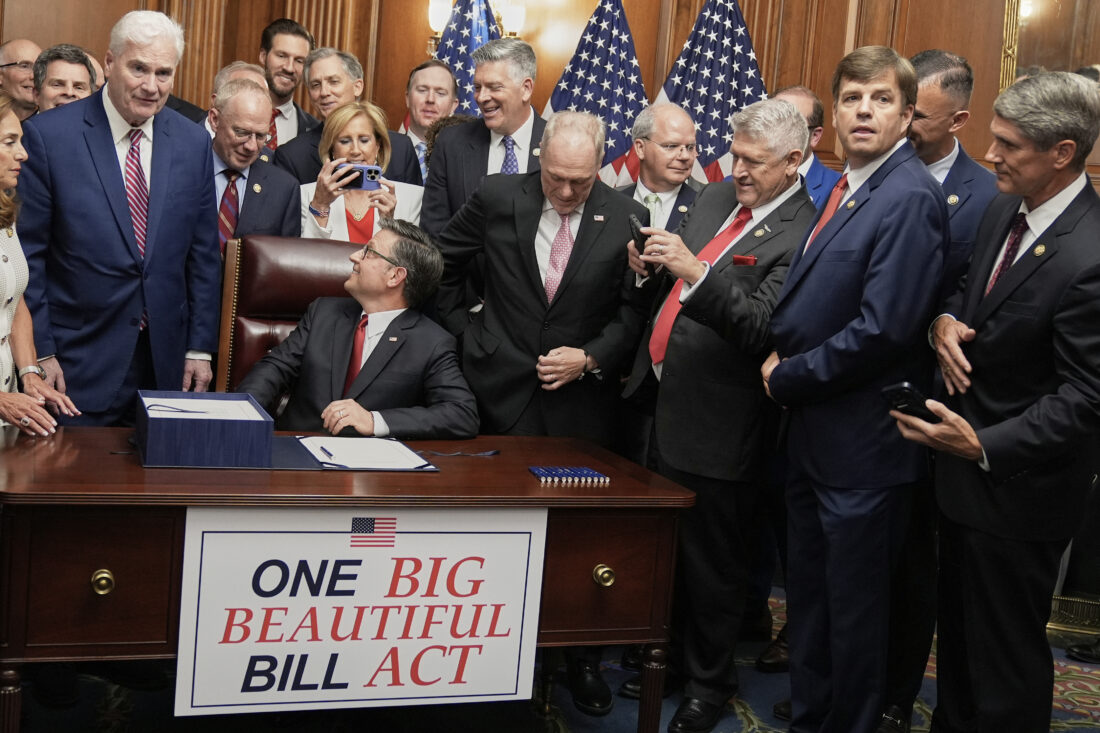State Counties Content On Gravy Train
Editor's Corner

Speaker of the House Mike Johnson, R-La., center, looks to fellow Republicans after signing President Donald Trump’s One Big Beautiful Bill Act. County leaders in New York state are not as celebratory regarding the ramifications. AP photo
Oswego and Chautauqua counties share a number of similarities. For starters, in terms of population, Chautauqua ranks 23rd out of 62 New York state counties with 124,000 residents while Oswego is 24th with 118,000.
Both also are located along shorelines of the Great Lakes — Lake Erie here, Lake Ontario to the east — and are often walloped in the winter by lake-effect snowstorms. The pair also boast a major campus tied to the State University of New York. Locally, it is Fredonia while Jamestown Community College serves as a two-year school. Its counterpart also is home to its namesake, which had nearly 7,000 students enrolled at its location — or more than double that of the north-county campus here.
In addition, both are oversized when it comes to representation for its constituency. The Oswego County Legislature has 25 members while Chautauqua County has six fewer at 19.
One of the differences, however, comes in leadership. Oswego County has an administrator in Phil Church who is appointed by the Legislature while Chautauqua County has an executive position — held by incumbent PJ Wendel who is seeking re-election this year against challenger Tom Carle — that is decided upon by the voters.
Church has held that position since 2007, which makes it more manager-focused — and less political. Besides supervising the appointed department heads of the 1,000-plus workforce, he develops and manages the $266 million budget for 2025.
Additionally, he is the one tasked with being the principal negotiator of tax agreements with nuclear power generators. That was a task that was previously handled by the Chautauqua County Industrial Development Agency until the NRG plant was shuttered in 2016.
Owned by Constellation Energy, Oswego County is home to Nine Mile Point Units 1 and 2 and the James A. FitzPatrick plant. Both have provided electricity to homes and businesses since 1970. Together, they produce about 2,708 megawatts (MW) of power, and provide approximately half of the state’s zero-emission electricity.
This week, Church took on one more charge to his busy agenda: he was formally elected president of the New York State Association of Counties during the annual meeting in Niagara Falls. “I am honored to lead NYSAC as we begin our 101st year of service,” he said in a news release. “Counties are navigating a time of great change in technology, policy, and community needs. Together, we will build on a century of collaboration to deliver solutions that protect taxpayers and strengthen the vital services our residents rely on.”
Let’s hope he’s serious about collaboration for the Association. All too often this group gets caught up in the premise of growing government — not downsizing it, especially when you consider the continuing exodus from upstate. With fewer residents and businesses to tax, county officials statewide are focusing on more aid — and Medicaid support — from Albany in light of the “One Big Beautiful Bill Act” being approved by Congress earlier this summer.
During this week’s meeting, the Association noted under the federal law, significant fiscal and administrative responsibilities will be shifted to states and counties — particularly in the areas of health care and nutrition. With $1.3 billion in projected new costs for counties statewide, leaders at the conference emphasized the urgency of a strong state partnership to manage the transition without undermining public services or raising property taxes.
“Counties are on the frontlines of delivering Medicaid and (Supplemental Nutritional Assistance Program) services, and we’re committed to doing so as efficiently as possible, but we can’t manage this federal overhaul alone,” Church said. “We need our partners at the state to provide real support — not just to protect county budgets, but to protect the New Yorkers who depend on these essential programs.”
One more commonality between Chautauqua and Oswego counties is its support of current President Donald Trump in the 2024 election. Like it or not, it is Trump — and Congressional Republicans — who are adding these burdens to the Association, which is not looking at making reductions or considering partnerships or sharing services for the smaller populations they are serving.
In fact, county leaders — if anything — are hoping to take more from your pockets in the future. One of their resolutions in Niagara Falls called for the governor and state Legislative leaders to “permanently extend all existing local sales tax rates and allow all counties to set their local rate.” This, the resolution noted, was in response to “increasing pressure from the federal government to pay a share of federal program costs.”
Almost everyone complains about inflation. But too many residents are quick to forgive the layers of local government that refuse to consolidate and make reductions while passing on higher costs to the remaining taxpayers.
This New York State Association of Counties shares in this guilt, according to its website.
In the section on Shared Services, the association notes that “by pooling resources and coordinating efforts with municipalities, school districts, fire districts, libraries, and other public entities, counties have saved taxpayers millions of dollars and optimized the delivery of services various areas of government operations, including public works, transportation, information technology, and emergency services.”
Perfect. Until you look at the last entry on the web page. It is from 2019.
Instead of pontificating about what the higher entities of government can do to ease the pain, how about these county officials statewide taking a more active role in seeking efficiencies or other solutions?
We’ve said it in this corner before. Looking at adding revenue with a stagnant population only puts already high-taxed residents at greater risk. It is time for entities at all levels, including the state, to scrutinize municipal expense lines that are often untouchable.
Making pleas for more money is a vicious cycle. One that keeps dinging the overburdened upstate taxpayers.
John D’Agostino is editor of The Post-Journal, OBSERVER and Times Observer in Warren, Pa. Send comments to jdagostino@observertoday.com or call 716-487-1111, ext. 253.





